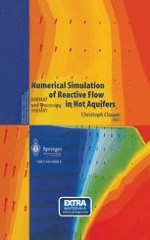
2003 | OriginalPaper | Chapter
Introduction
Authors : Christoph Clauser, Jörn Bartels
Published in: Numerical Simulation of Reactive Flow in Hot Aquifers
Publisher: Springer Berlin Heidelberg
Included in: Professional Book Archive
Activate our intelligent search to find suitable subject content or patents.
Select sections of text to find matching patents with Artificial Intelligence. powered by
Select sections of text to find additional relevant content using AI-assisted search. powered by
SHEMAT (Simulator for HEat and MAss Transport) is an easy-to-use, general purpose reactive transport simulation code for a wide variety of thermal and hydrogeological problems in two and three dimensions. Specifically, SHEMAT solves coupled problems involving fluid flow, heat transfer, species transport, and chemical water-rock interaction in fluid-saturated porous media. It can handle a wide range of time scales. Therefore, it is useful to address both technical and geological processes. In particular, it offers special and attractive features for modeling steady-state and transient processes in hydro-geothermal reservoirs. This makes it well suited to predict the long-term behavior of heat mining installations in hot aquifers with highly saline brines. SHEMAT in its present form evolved from a fully coupled flow and heat transport model (Clauser 1988) which had been developed from the isothermal USGS 3-D groundwater model of Trescott and Larson (Trescott 1975; Trescott and Larson 1977). Transport of dissolved species, geochemical reactions between the solid and fluid phases, extended coupling between the individual processes (most notably between porosity and permeability), and a convenient user interface (developed from Processing Modflow (Chiang and Kinzelbach 2001)) were added during several research projects funded by the German Science Foundation (DFG) under grant CL 121/7 and the German Federal Ministries for Education, Science, Research, and Technology (BMBF) under grant 032 69 95A-D and for Economics and Technology (BMWi) under grant 0327095 (Bartels et al. 2002, Kühn et al. 2002a).